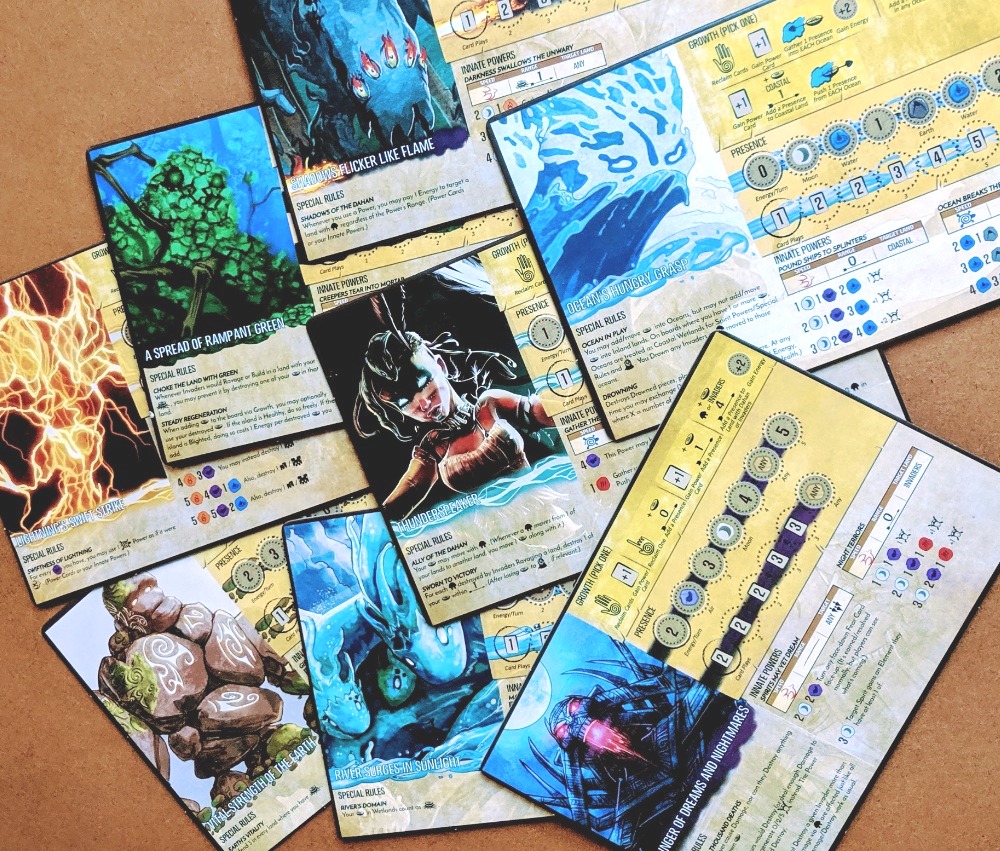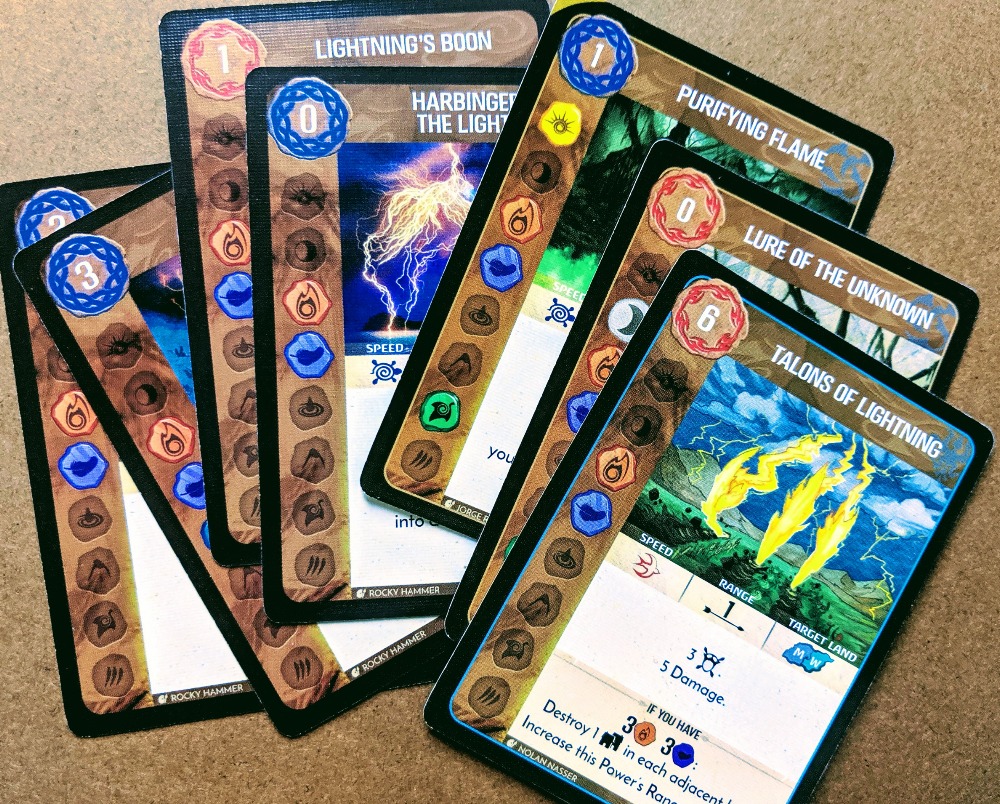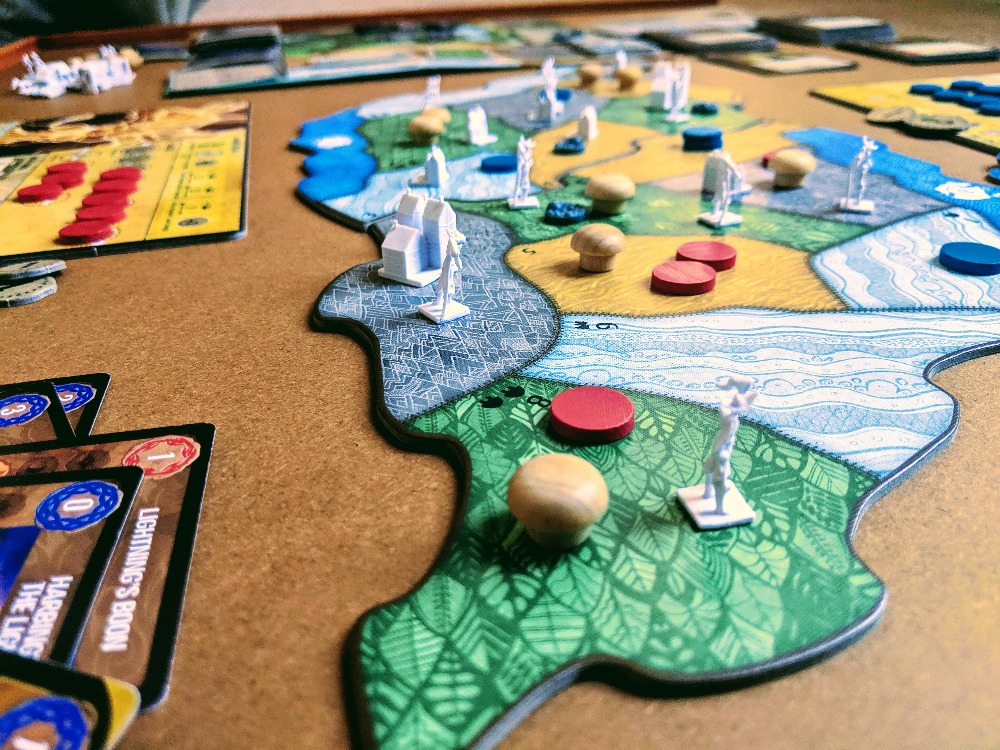“As my growth option, I am adding my presence to this coastal wetland and also emerge with the tide from the oceans. I am also picking a major power card… OMG it’s a Tsunami!”
“Can you use it this round?”
“Nope, I don’t have enough energy.”
“Damn, alright. I am going to add a presence here and take 4 energy.”
“Right, so in the speedy phase, I am going to gather these two explorers to thwart their building attempts. I will also add defend 4 to this jungle to help during the ravage. Can you add some dahan in the mix?”
“Hmm, okay. As a speedy I will also add defend 3 to this other jungle and gather some dahan to yours so they can fight the invaders. Long-term I will clean up this mountain area, destroying all the cities, and I can also move some natives around.”
“I can’t reach that jungle though, let’s hope the Fear card will save us.”
*flips the Fear card*
“It just defends on all coastal lands. Dammit.”
“Okay, invader phase.”
“These ravage themselves, nothing happens here, and in this area they taint the land and it cascades.”
“We just lost on blight.”
Spirit Island is a co-operative settler destruction game. I was not aware this is a distinct board game genre, but it is on the box so it must be. In the game players take on the mantle of spirits who are called upon to defend the island and the native population (called the Dahan) from the pesky European invaders. The goal of the game is to defeat the explorers by either slaughtering all of them or scaring them away, before they destroy the island.
Each turn consists of four phases.
In the growth phase, the spirits have a chance to increase their power in various ways. See, an interesting aspect of the game is that spirits are not really corporeal, they don’t have a physical body on the island, and since only their presence is … present, they can’t be directly attacked either. However, you must spread that presence through the island in order to be able to use your powers later. You can also gain new powers to use, rest and refresh your hand, or gain energy you will need to cast powers later. The beauty of the game is that all the spirits have different growth options, one can reclaim all the cards easily, others can place more presence, or have more exotic options, and this alone sets the spirits distinctly apart.
Next, you can attack the invaders who dared to set foot on your favourite island. You do that by using your powers from either your starter cards, the ones you acquired while you were growing, or the innate powers built into your spirit. Now, some of these attacks are direct (do X amount of damage in a territory), but more often than not, you are using the environment or the native population against the invaders. The cards provide you with an arsenal of huge variety, you can push the invaders away, make them fight the natives, scare them, set beasts upon them, scare them even more, volcano, lightning, tsunami, earthquakes, droughts, etc. There is no strict order, the spirits can play cards in the order they want to, which gives you a lot to think about when you plan your strategy.

Once you made your move, it’s the invaders turn. In each round a random territory type will be selected, and those are the lands the invaders set their eyes upon. So they are going to send out their explorers to chart the area. Invaders can explore on the shore and in areas near towns/cities. They are pushing further and further inland, conquering new lands and building new settlements. This is the randomness part, you never know which lands they are going to go for next. However, in the next round, the cards will shift, so the previously explored areas will be very predictably built upon, first just an innocent-looking town, and then a city, and before you realize, you have an unstoppable capital on your hand! One more round later they will ravage on the same territory. Ravaging is basically doing agriculture, but that’s bad, because, as we know, trees good, machines bad. This predictability of knowing which areas to concentrate on two rounds in advance puts a lot of responsibility on the players, after all, you are fully aware of what is coming, and it’s all the more depressing when you can’t stop it. More on the ravages later.
Finally, the spirits have another go using their slow powers. Yes, the powers in the earlier paragraph were the fast powers, but didn’t want to throw more technical mumbo-jumbo at you back then! Slow powers are usually more powerful than their fast counterparts, but they are also, you know, slower. This means you have to think further ahead, because by the time you can use them, an invader phase happened, and you have to pick the cards ahead. For example, you might have a slow power that lets you make some explorers go away, but as of now, there are no explorers in sight. However, using your superbrain, you calculate that after the invader phase, there will be some somewhere, and hopefully you will be able to reach them from the presence you have.
And that’s basically the game, rinse and repeat.
When the game starts, your win condition is to kill all the invaders. That is straightforward, but nearly impossible. However, as the game progresses, the invaders become more and more scared due to the hostile work environment, and their commitment becomes a bit more… lax. After a while, if you manage to destroy all the buildings, they would call that a tie and go home. Even more scaring later, you only have to destroy the big cities. And finally, you just scare them away, but that’s a lot of scaring that needs to happen by then. We win the majority of the games by generating just enough fear to get the destroy cities win condition.
The most common way of losing the game is through ravaging invaders. Every round, they ravage on certain territories, and as a result, the local population is killed, your presence fades away, and most importantly, the land becomes blighted. Fail to stop that a couple of times, and you lose the game.
The game has a very natural steep escalation. As spirits build up fear the terror level will rise and the victory condition becomes easier, and the spirits will also become stronger and stronger with new powers, energy, and presence everywhere. However, the invaders also become more powerful, after a while, they explore on multiple territory types, they build up huge hubs that you just can’t get rid of, and the game always seems unwinnable. Overall it does give you a sense of doom how more and more areas get taken over, and cities and towns just keep popping up everywhere, while the spirits desperately fight for their land.
The Good
The spirit design is probably the best part of the game. The artwork, the player mat, the difficulty rating, the abilities, the little snippets of story and play style, the bar chart about the strength and weaknesses of the spirit. All of it gives each spirit a very unique feel and style, making it very enjoyable to just play through the game 10 times with different spirits.

The distinction between rapid and slow abilities also adds to the play styles of the spirits. Some spirits are quick as lightning, while other are slow as the ocean washing on the shores of the island. Some are somewhere between these two, like a giant smoke of fear, slowly and rapidly scaring everyone to death.
The spirits also feel very thematic. At first I thought that all of us picking power cards from the same deck will dilute each spirit’s unique feel, but I couldn’t have been further from the truth. Because of the connection between the elemental symbols and the innate abilities you will keep picking cards around the same themes. For example, if you have a spirit that uses fire and earth for their innate ability, you will keep picking power cards with those elements and therefore building a very consistent deck. The theme of each spirit translates very well into gameplay. There is one that embodies the ocean and can protect coastal lands easily and summon great floods. Another one is the spirit of the spread of rampant green and it can prevent new settlements from popping up by basically spreading the rampant green jungle. Lighting’s swift strike is good at devastating rapid abilities destroying towns, and the bringer of nightmares is the embodiment of spreading fear.

Due to the difficulty of the game Spirit Island hits that special sweet spot where you have to discuss a high-level strategy but can’t micro-manage each other’s turns. It would be somewhere halfway between Eldritch Horror and Mage Knight in that aspect.
The game is also very addictive, we played ten games in the first two days of owning the game and haven’t stopped since then.
There is also a ton of content in the base game. You can choose from different adversaries, scenarios, blight cards, all meant to change some core mechanisms of the game and add great replay value to the game. Each of these modifications will change the difficulty rating of the game, so you can have a mini-tournament with yourselves to see how high can you crank up the difficulty and still win. For example, during one of the scenarios the spirits have to perform a quite difficult ritual of terror multiple times to drive out the explorers. Fighting the adversary England will alter the game as they build a lot quicker and easier than the default invaders.
The game is also excellent with two players, it scales very well. It might actually be more difficult with more players since thinking through all the combinations of spirit abilities would require a supercomputer.
The Bad
No game is perfect and Spirit Island is no exception.
The plastic figures are lame, half the explorers are bent and they just don’t look good. I think I would have been much happier with colourful wooden blocks.
The overall play is not very elegant. It requires a lot of shifting cards, pushing tokens around, a lot of administration to keep the game going. The iconography isn’t exactly intuitive, you just have to remember what everything does. The word damage is printed on each card, while fear is replaced by an icon even though the word “damage” is 50% longer than “fear”.
The difficulty level has many variations with different scenarios, adversaries and island boards. On the one hand that is intriguing, on the other it requires some work to figure out which one fits you. It is also unclear how the difficulty levels were set exactly. For example, playing against England with spirits that can destroy cities and town is easier. So does this mean that the difficulty rating assumes you play with those or would using specific spirits actually bring the difficulty down some levels? Unclear.
The rule book is a bit clunky, but you only have to go through it once or twice. Still, at the beginning you will have to keep double-checking rules. The map is also unintuitive, the rules for combining the pieces won’t be clear at first. There is also a distinction between coastal and inland lands, however, the island is not depicted to be surrounded by ocean on the map. You can probably imagine that there is some great mountain range or desert that blocks off the rest. I understand that they probably couldn’t balance the game properly or come up with an island board design that enables it being encircled by water, but it still feels clunky.

This is a personal issue of mine, there are no green tokens in the game, only blue, yellow, red, and violet. What am I supposed to pick if I am playing with the rampant green spirit? Yellow?
The game also mentions spirits that are not part of the base game when assessing the difficulty of some scenarios/adversaries. Not cool, trying to get me to buy expansions, which I absolutely have done already, but it is still not cool.
The map also has two sides: a default one and a thematic one. The latter is considered more real, the different land types are more clustered, you have large continuous mountain ranges and river wetlands, they are not all nicely mixed up as on the default map. This also means that invaders will also cluster, so it is harder for every spirit to reach the problematic land types, and it is easier for the blight to cascade all over the place. The idea of the thematic map is great, but the execution could have been better. Some of the areas are pretty small, so it is easy to run out of space, some areas have icons printed on them that are only available in the expansion (not cool, game), and overall it is pretty hard to see where the borders are.
The Co-Op
Oh yes, oh yes, the game is co-operative as hell. There are some spirits that can work together beautifully, enhancing each other’s strengths. For higher difficulties, you really need to think through your spirit choices and coordinate your strategies. For example, we struggled against England and had to try at least five different combinations of spirits until we found the ocean and river one. The ocean can very effectively keep the coastal lands clear and the river is great at washing out invaders, pushing them towards the ocean’s hungry grasp.
You really need to pay attention to each other, you won’t be able to micro-manage the other player, but you have to have a comprehensive overall plan that you work towards together in order to win.
There are also a bunch of cards that impact other spirits, for example letting them put down a presence or choose elements or get energy. There is even a great serpent spirit in the promo pack that can eat another spirit’s presences and then aid them through its innate abilities.
The Recommendation
Spirit Island is an absolutely amazing game, we just can’t get enough of it. This game has one of the best replay value I have ever experienced.
It is not necessarily a gamer’s game, especially on the lower difficulty levels, but I also wouldn’t call it a gateway game. Definitely recommended for board game veterans, newer players would have to be eased into it. On higher difficulty levels it does become very involved, players would sometimes spend minutes just sitting looking at their cards trying to figure out what to do.
Info
| Release Year | 2017 |
| Genre | Strategy |
| Difficulty | Hard |
| Number of Players | 1 to 4 |
| Length | 1 - 3 hours, depending on difficulty level |
Rating
| Overall | Great |
| Story | Good |
| Co-Operation | Great |